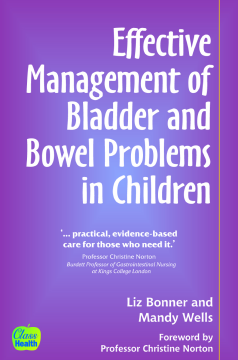
BOOK
Effective Management of Bladder and Bowel Problems in the Child
(2007)
Additional Information
Book Details
Abstract
Childhood incontinence is often neglected as a major focus for healthcare professionals, the assumption being that all children will eventually grow out of any problems they may have. However, many do not and this can lead to the devastating effects of incontinence on a child's social, mental and physical health.
This comprehensive text explores all continence problems in children and gives practical, easy-to-adopt guidance on how they can be controlled and managed in the clinical and community setting. Chapters are written by leading practitioners from a range of disciplines: nursing, medicine, surgery, psychology and education. The book emphasises the importance of thorough assessment and identification of the causes of incontinence, and advises on addressing problems in the most appropriate way for the individual child.
Busy practitioners will welcome having key points highlighted at the start of each chapter, as well as extensive real case studies, useful resources, and a full glossary of key terms.
Topics covered include:
•How to safeguard children and how to communicate effectively with parents •Relevant anatomy and physiology of bladder and bowel •Tests and investigations to identify bladder and bowel dysfunction •Surgical perspectives and other forms of management •Dealing with psychological issues and long-term difficulties •Strategies for developing integrated paediatric continence servicesTable of Contents
| Section Title | Page | Action | Price |
|---|---|---|---|
| Effective Management of Bladder and Bowel Problems in Children | Cover | ||
| Half Title Page | i | ||
| Title Page | iii | ||
| Copyright | iv | ||
| Contents | v | ||
| Foreword | ix | ||
| Acknowledgements | x | ||
| About the contributors | xi | ||
| Introduction | 1 | ||
| 1 Safeguarding children and young people with continence difficulties | 5 | ||
| 2 Involving and communicating with patients | 24 | ||
| 3 Embryology of the urogenital tract and pelvic floor | 40 | ||
| 4 Anatomy and physiology of the urinary system, and some common problems | 56 | ||
| 5 Anorectal anatomy and physiology | 71 | ||
| 6 Investigations for bladder problems | 82 | ||
| 7 Nocturnal enuresis | 103 | ||
| 8 Faecal soiling in childhood | 122 | ||
| 9 Urinary tract infection in childhood | 142 | ||
| 10 Surgical assessment and management of urinary continence in children with neuropathic bladder | 161 | ||
| 11 A surgical perspective on intractable faecal incontinence | 177 | ||
| 12 Psychological issues of incontinence | 183 | ||
| 13 Holistic assessment for adaptations, equipment and product needs | 205 | ||
| 14 Managing clean intermittent catheterisation | 224 | ||
| 15 Transition through childhood and into adult life | 240 | ||
| 16 Continence issues in schools | 259 | ||
| 17 Strategy for developing integrated paediatric continence services | 279 | ||
| 18 Ensuring proficiency | 294 | ||
| 19 Governance and standards for better health | 315 | ||
| Glossary | 344 | ||
| Appendix 1 – ERIC and other resources | 349 | ||
| Appendix 2 – The part played by incontinence in Victoria Climbié’s tragedy | 354 | ||
| Appendix 3 – Statement of inter-professional values underpinning work with children and young people | 356 | ||
| Index | 359 |
